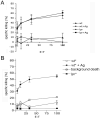Distinct roles of cytolytic effector molecules for antigen-restricted killing by CTL in vivo
- PMID: 20309009
- PMCID: PMC2939217
- DOI: 10.1038/icb.2010.37
Distinct roles of cytolytic effector molecules for antigen-restricted killing by CTL in vivo
Abstract
Cytotoxic T lymphocytes (CTLs) represent one of the front lines of defense for the immune system, killing virus-infected and tumor-transformed cells. CTL use at least two mechanisms to induce apoptosis in their targets, one mediated by perforin and granzymes, and the other triggered by the death ligand, CD95 ligand (CD95L). Here, we used an in vivo cytotoxicity assay to measure specific clearance of antigen-bearing target cells in mice that had previously been immunized with noninfectious cell-associated antigens. We found that perforin was dispensable for efficient clearance of antigen-bearing cells from immunized mice, but only if CD95/CD95L was functional; however, there was a delay in target cell clearance in the absence of perforin. In addition, we observed ∼35% target cell clearance in the absence of both perforin and CD95L, which was only slightly abrogated in the presence of a neutralizing anti-tumor necrosis factor (TNF) antibody. The presence of a dominant negative Fas-associated death domain (FADD) did not block target cell clearance and therefore cannot be attributed to known death receptors. Taken together, these data suggest that perforin- and CD95L-dependent killing are complementary at early time points, each can compensate for the absence of the other at later time points, and that there is an additional component of antigen-restricted CTL killing independent of perforin, CD95L, and TNFα.
Conflict of interest statement
The authors declare no conflict of interest.
Figures


Similar articles
-
Tumor-specific CTL kill murine renal cancer cells using both perforin and Fas ligand-mediated lysis in vitro, but cause tumor regression in vivo in the absence of perforin.J Immunol. 2002 Apr 1;168(7):3484-92. doi: 10.4049/jimmunol.168.7.3484. J Immunol. 2002. PMID: 11907109
-
Virally infected hepatocytes are resistant to perforin-dependent CTL effector mechanisms.J Immunol. 2001 Aug 1;167(3):1566-74. doi: 10.4049/jimmunol.167.3.1566. J Immunol. 2001. PMID: 11466378
-
IL-4 diminishes perforin-mediated and increases Fas ligand-mediated cytotoxicity In vivo.J Immunol. 2000 Apr 1;164(7):3487-93. doi: 10.4049/jimmunol.164.7.3487. J Immunol. 2000. PMID: 10725701
-
Fas- and perforin-independent mechanism of cytotoxic T lymphocyte.Immunol Res. 1998;17(1-2):89-93. doi: 10.1007/BF02786434. Immunol Res. 1998. PMID: 9479571 Review.
-
Cellular mechanisms of lymphocyte-mediated lysis of tumor cells.Ann Ist Super Sanita. 1990;26(3-4):369-84. Ann Ist Super Sanita. 1990. PMID: 2151107 Review.
Cited by
-
Host adaptive immunity deficiency in severe pandemic influenza.Crit Care. 2010;14(5):R167. doi: 10.1186/cc9259. Epub 2010 Sep 14. Crit Care. 2010. PMID: 20840779 Free PMC article.
-
Decitabine immunosensitizes human gliomas to NY-ESO-1 specific T lymphocyte targeting through the Fas/Fas ligand pathway.J Transl Med. 2011 Nov 7;9:192. doi: 10.1186/1479-5876-9-192. J Transl Med. 2011. PMID: 22060015 Free PMC article.
-
Use of the Human Granulysin Transgenic Mice To Evaluate the Role of Granulysin Expression by CD8 T Cells in Immunity To Mycobacterium tuberculosis.mBio. 2022 Dec 20;13(6):e0302022. doi: 10.1128/mbio.03020-22. Epub 2022 Nov 21. mBio. 2022. PMID: 36409085 Free PMC article.
-
Immunotherapy in Head and Neck Cancer.Cancer Treat Res. 2025;129:119-156. doi: 10.1007/978-3-031-97242-3_7. Cancer Treat Res. 2025. PMID: 40847232 Review.
References
-
- Cullen SP, Martin SJ. Mechanisms of granule-dependent killing. Cell Death Differ. 2008;15:251–62. - PubMed
-
- Stinchcombe JC, Griffiths GM. Secretory mechanisms in cell-mediated cytotoxicity. Annu Rev Cell Dev Biol. 2007;23:495–517. - PubMed
-
- Trambas CM, Griffiths GM. Delivering the kiss of death. Nat Immunol. 2003;4:399–403. - PubMed
-
- Stinchcombe JC, Griffiths GM. The role of the secretory immunological synapse in killing by CD8+ CTL. Semin Immunol. 2003;15:301–5. - PubMed
-
- Isaaz S, Baetz K, Olsen K, Podack E, Griffiths GM. Serial killing by cytotoxic T lymphocytes: T cell receptor triggers degranulation, re-filling of the lytic granules and secretion of lytic proteins via a non-granule pathway. Eur J Immunol. 1995;25:1071–9. - PubMed
Publication types
MeSH terms
Substances
Grants and funding
LinkOut - more resources
Full Text Sources
Research Materials
Miscellaneous

